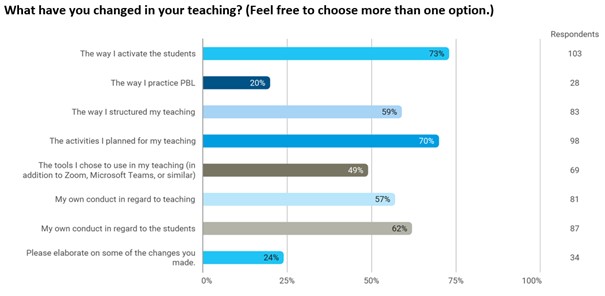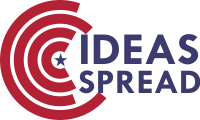How do We Conduct Teaching at Universities in the Future? A Study Illustrating How, Where, and Why Teachers and Students Disagree About Hybrid Teaching Formats
Abstract
This empirical study investigates students’ and teachers’ preferences and experiences with hybrid teaching formats at the university level. In the presented teaching format, students and teachers attend sessions either on campus or online. Some students always participated from campus, others changed between campus and being online. The research shows surprising insights: students and teachers clearly disagreed about the experienced usefulness of the hybrid teaching formats, and whether to use hybrid teaching formats in the future. Out of 849 respondents, app. 80% of teachers prefer to teach at campus, app. 80% of students want the hybrid solution, despite the technical and pedagogical issues encountered. Findings show a need for the development of hybrid pedagogies and didactics preparing teachers for teaching in hybrid teaching formats and point to the need for a more general discussion about how universities and society at large want to conduct teaching in higher education in the future.
References
Barge, S. (2010). Principles of problem and project based learning: The Aalborg PBL model. Aalborg Uni-versity. https://www.aaudxp-cms.aau.dk/media/mmmjbthi/pbl-aalborg-model_uk.pdf
Beatty, B. (2012). HyFlex course design: The advantages of letting students choose the blend. In 9th An-nual Sloan Consortium Blended Learning Conference & Workshop. https://www.igi-global.com/gateway/chapter/203941
Beatty, B. J. (2019a). Values and principles of hybrid-flexible course design. In B. J. Beatty (Ed.), Hy-brid-flexible course design: Implementing student-directed hybrid classes. EdTech Books. Retrieved from https://edtechbooks.org/hyflex/hyflex_values
Beatty, B. J. (2019b). Expanding the implementation of hybrid-flexible courses and programs: Encourag-ing the adoption of HyFlex within the institution. In B. J. Beatty (Ed.), Hybrid-flexible course design: Implementing student-directed hybrid classes. EdTech Books. https://edtechbooks.org/hyflex/adoption
Bower, M., Dalgarno, B., Kennedy, G. E., Lee, M. J. W., & Kenney, J. (2015). Design and implementation factors in blended synchronous learning environments: Outcomes from a cross-case analysis. Com-puters & Education, 86, 1–17. https://doi.org/10.1016/j.compedu.2015.03.006
Butz, N. T., & Stupnisky, R. H. (2016). A mixed methods study of graduate students’ self-determined moti-vation in synchronous hybrid learning environments. The Internet and Higher Education, 28, 85–95. https://doi.org/10.1016/j.iheduc.2015.10.003
Bülow, M. W. (2022). Designing synchronous hybrid learning spaces: Challenges and opportunities. In E. Gil, E. Mor, Y. Dimitriadis, & C. Köppe (Eds.), Hybrid learning spaces. Springer. https://doi.org/10.1007/978-3-030-88520-5
Cain, W., Bell, J., & Cheng, C. (2016). Implementing robotic telepresence in a synchronous hybrid course. In Proceedings of IEEE 16th International Conference on Advanced Learning Technologies, ICALT 2016 (pp. 171–175). https://doi.org/10.1109/ICALT.2016.79
Creswell, J. W. (2008). Educational research: Planning, conducting, and evaluating quantitative and qualitative research (3rd ed.). Prentice Hall.
Cunningham, U. (2014). Teaching the disembodied: Othering and activity systems in a blended synchro-nous learning situation. International Review of Research in Open and Distributed Learning, 15(6), 33–51. https://doi.org/10.19173/irrodl.v15i6.1793
DESI (2022). Digital Economy and Society Index – Denmark, country report. https://ec.europa.eu/newsroom/dae/redirection/document/88699
Eurostat (2022). 41% of young adults hold a tertiary degree. Retrieved from https://ec.europa.eu/eurostat/web/products-eurostat-news/-/ddn-20220524-2
Eyal, L., & Gil, E. (2022). Hybrid learning spaces — A three-fold evolving perspective. In E. Gil, E. Mor, Y. Dimitriadis, & C. Köppe (Eds.), Hybrid learning spaces. Springer. https://doi.org/10.1007/978-3-030-88520-5
Flyvbjerg, B. (2006). Five misunderstandings about case-study research. Qualitative Inquiry, 12(2), 219–245. https://doi.org/10.1177/1077800405284363
Future Learning Spaces. (2023). Hybrid active learning classroom. Utrecht University. Retrieved January 2, 2023. https://www.uu.nl/en/education/future-learning-spaces/learning-spaces/hybrid-active-learning-classroom
Georgsen, M., & Qvortrup, A. (Eds.). (2021). Erfaringer og oplevelser med online undervisning på 9 vide-regående uddannelsesinstitutioner i foråret 2020. https://laeremiddel.dk/wp-content/uploads/2021/02/COVID-19-undervisning-f%C3%A6rdig-rapport.pdf
Hastie, M., Hung, I. C., Chen, N. S., & Kinshuk. (2010). A blended synchronous learning model for educa-tional international collaboration. Innovations in Education and Teaching International, 47(1), 9–24. https://doi.org/10.1080/14703290903525812
Jelsbak, V., Buus, L., & Thorsen, J. (2018). God kvalitet i livestreamet undervisning–fra underviserens point of view. Tidsskriftet Læring Og Medier (LOM), 11(18). https://tidsskrift.dk/lom/article/view/25407
Jensen, R. H. S., Ørngreen, R., Hautopp, H., Knudsen, S. P., Sterregaard, J. S., & Vesterheden, L. R. (2023). Afrapportering Fremtidens Undervisningslokale, Aalborg University. https://vbn.aau.dk/da/publications/afrapportering-fremtidens-undervisningslokale
Klunder, S., Saab, N., & Admiraal, W. (2022). A teacher perspective on using a hybrid virtual classroom for students with a chronic illness in mainstream primary and secondary schools. Technology, Pedagogy and Education. https://doi.org/10.1080/1475939X.2022.2033824
Kokko, M., Pramila-Savukoski, S., Ojala, J., Kuivila, H. M., Juntunen, J., Törmänen, T., & Mikkonen, K. (2024). The effect of educational intervention on hybrid teaching competence of health sciences and medical educators’ – a mixed methods study. Scandinavian Journal of Educational Research, 1–16. https://doi.org/10.1080/00313831.2024.2369860
Lakhal, S., Bateman, D., & Bédard, J. (2017). Blended synchronous delivery modes in graduate programs: A literature review and its implementation in the master teacher program. Collected Essays on Learn-ing and Teaching, 10, 47–60. https://files.eric.ed.gov/fulltext/EJ1147188.pdf
Lightner, C. A., & Lightner-Laws, C. A. (2016). A blended model: Simultaneously teaching a quantitative course traditionally, online, and remotely. Interactive Learning Environments, 24, 224–238. https://doi.org/10.1080/10494820.2013.841262
Lundberg, A., & Stigmar, M. (2022). University teachers’ shifting views of successful learning environ-ments in the future. Scandinavian Journal of Educational Research, 67(6), 964–979. https://doi.org/10.1080/00313831.2022.2115127
Lyngdorf, N. E. R., Bertel, L. B., & Andersen, T. (2021). Evaluering af Digitalt Understøttet Læring på Aalborg Universitet i 2020: Underviser- og studenterperspektiver på universitetets nedlukning som følge af Covid-19. https://vbn.aau.dk/ws/portalfiles/portal/441101526/Afrapportering_final.pdf
Ørngreen, R., & Knudsen, S. P. (2022). Afrapportering på strategisk rammekontrakt mål 5 - Studerendes vurdering af digital understøttet PBL E19-F21, Aalborg Universitet. https://vbn.aau.dk/da/publications/afrapportering-p%C3%A5-strategisk-rammekontrakt-m%C3%A5l-5-studerendes-vurd
Ørngreen, R., Levinsen, K., Jelsbak, V., Moller, K. L., & Bendsen, T. (2015). Simultaneous class-based and live video streamed teaching: Experiences and derived principles from the bachelor programme in biomedical laboratory analysis. In A. Jefferies & M. Cubric (Eds.), Proceedings of the 14th European conference on E-learning (ECEL 2015) (pp. 451–459). Academic Conferences and Publishing Inter-national Limited. https://www.academia.edu/19808141/Simultaneous_Class_based_and_Live_Video_Streamed_Teaching_Experiences_and_derived_principles_from_the_Bachelor_Programme_in_Biomedical_Laboratory_Analysis
Raes, A., Detienne, L., Windey, I., & Depaepe, F. (2019). A systematic literature review on synchronous hybrid learning: Gaps identified. Learning Environments Research. https://doi.org/10.1007/s10984-019-09303-z
Rivano, Eckerdal, J., & Hagström, C. (2017). Qualitative questionnaires as a method for information stud-ies research. Information Research, 22(1), CoLIS Paper 1639. https://informationr.net/ir/22-1/colis/colis1639.html
Sipes, S. M. (2017). Development of a problem-based learning matrix for data collection. Interdisciplinary Journal of Problem-Based Learning, 11(1). https://doi.org/10.7771/1541-5015.1615
Szeto, E., & Cheng, A. Y. N. (2016). Towards a framework of interactions in a blended synchronous learn-ing environment: What effects are there on students’ social presence experience? Interactive Learn-ing Environments, 24(3), 487–503. https://doi.org/10.1080/10494820.2014.881391
Wang, Q., Quek, C. L., & Hu, X. (2017). Designing and improving a blended synchronous learning envi-ronment: An educational design research. International Review of Research in Open and Distributed Learning, 18(3), 99–118. https://doi.org/10.19173/irrodl.v18i3.3034
Weitze, C. L., Ørngreen, R., & Levinsen, K. (2013). The global classroom video conferencing model and first evaluations. In I. M. Ciussi & M. Augier (Eds.), Proceedings of the 12th European conference on E-Learning: SKEMA Business School, Sophia Antipolis France, 30–31 October 2013 (Vol. 2, pp. 503–510). Academic Conferences and Publishing International. https://vbn.aau.dk/files/168255660/Weitze_Orngreen_The_Global_Classroom_video_conferencing_model_and_first_evaluations.pdf
Weitze, C. L. (2015). Pedagogical innovation in teacher teams: An organisational learning design model for continuous competence development. In I. A. Jefferies & M. Cubric (Eds.), Proceedings of 14th European conference on e-Learning ECEL-2015 (pp. 629–638). Academic Conferences and Publish-ing International. https://vbn.aau.dk/files/221284384/Charlotte_Weitze_Pedagogical_innovation_in_teacher_teams.pdf
Wiles, G. L., & Ball, T. R. (2013, June 23–26). The converged classroom. Paper presented at ASEE Annual Conference: Improving course effectiveness, Atlanta, Georgia. https://peer.asee.org/the-converged-classroom
Wright, D. (2016). The HyFlex course design: A case study on adult and career education courses. Nation-al Social Science Journal, 48(2), 88–93. Retrieved from https://www.researchgate.net/profile/Sean-Lennon/publication/315652360_Students'_Views_of_Civic_Principles_Values_and_Constitutional_Rights_and_Responsibilities/links/58d7dac5a6fdcc1baeb6717f/Students-Views-of-Civic-Principles-Values-and-Constitutional-Rights-and-Responsibilities.pdf?_sg%5B0%5D=started_experiment_milestone&origin=journalDetail&_rtd=e30%3D#page=91
Zydney, J. M., McKimm, P., Lindberg, R., & Schmidt, M. (2019). Here or there instruction: Lessons learned in implementing innovative approaches to blended synchronous learning. TechTrends. https://link.springer.com/article/10.1007/s11528-018-0344-z


This work is licensed under a Creative Commons Attribution 4.0 International License.
Copyright for this article is retained by the author(s), with first publication rights granted to the journal.
This is an open-access article distributed under the terms and conditions of the Creative Commons Attribution license (http://creativecommons.org/licenses/by/4.0/).








1.png)

















